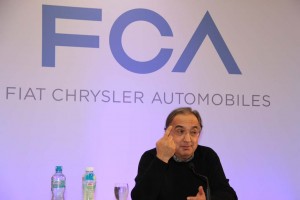Fiat says its second-quarter profits plunged 55% as the maker’s U.S. partner Chrysler struggled to move old product with new incentives, while the Fiat side of the company dealt with a slowdown in South America.
Fiat, which expects to complete its takeover of the U.S. maker in October, earned a net profit of 197 million Euros, or $264 million, for the three-month period ending on June 30, compared with 435 million Euros a year before. On an EBIT – or earnings before interest and taxes – basis, the numbers dipped to 961 million Euros, or $1.3 billion, from 1.1 billion Euros a year earlier.
“We had a crappy first quarter, a halfway decent second, and we need to have outstanding quarters in the third and fourth,” Sergio Marchionne, CEO of both Fiat and Chrysler, said bluntly during a conference call.
The downturn came despite the fact that it sold more vehicles during the latest quarter, a total of 1.18 million, up 2% worldwide. Revenues, meanwhile, were up 1 billion Euros, to 23.3 billion. The Chrysler side of the company saw a 10% increase in sales during the quarter compared to a year earlier.
But it cost more to sell those vehicles. In June, Chrysler had the highest incentives of any automaker operating in the U.S. market, at an average $3,480 per vehicle. That was $106 more than Ford and $200 over General Motors. It was also 3.7% above Chrysler’s incentive level in June 2013, according to data tracking firm TrueCar.com.
“It is something that we obviously intend to remedy,” Marchionne asserted. “I think we need to become a lot more disciplined on the pricing side of this.”
How quickly Chrysler can trim back on those incentives – at least without losing sales and market share – is a question that remains to be answered, however. The Detroit maker is still marketing some old products – such as long-in-the-tooth Dodge Journey crossover and Caravan minivan, and Jeep Compass and Patriot SUVs. And it has had to boost givebacks on some newer, but slow-selling models like the Dodge Dart.
From a bottom line perspective, incentives brought North American net income down to 598 million for the quarter, or $801 million. A year earlier, it netted 733 million, or $982 million.
Chrysler’s bulging incentive spending, however, was not the only problem underlying Fiat’s weak second-quarter performance. The Fiat side of the company had plenty of problems, as well. It has been hard hit by the ongoing recession – which only recently appeared to have bottomed out – because its traditional markets, like Italy, had some of the biggest financial problems. Fiat did manage to cut its losses in Europe to 6 million from 69 million a year ago. But it is in the midst of a costly restructuring program not likely to yield significant, short-term results.
(Fiat’s 500-Vans concept tapping into “board” culture. For more, Click Here.)
Fiat also had its challenges in the U.S. where its own brand revival is showing questionable results, especially with the launch of its second model-line, the 500L. On the positive side, the maker’s Maserati brand has been delivering record sales in the U.S. and other parts of the world.
(Click Here for details about Chrysler recalling 800,000 vehicles.)
Fiat had bigger problems in Latin America, traditionally a strong base, with vehicle sales dipping 21%, while profits were off 72% to 62 million Euros.
Both sides of the company have been pressing to improve their joint presence in markets around the world. Chrysler recently announced plans for its Jeep brand to resume production in China after a long absence.
(To see more about Maserati’s long-term sales plans, Click Here.)
“We have really tried to move away from the sand box that this company has historically played in,” said Marchionne.
Chrysler’s financial results were included in Fiat’s numbers as part of its NAFTA division. The U.S. maker will report separately on the second quarter on August 11. Later this year, the new Fiat Chrysler Automobiles is expected to formally consolidate its reporting under one banner – if, that is, the merger is completed, as planned, in October. The company also expects to follow that by listing its shares on the New York Stock Exchange.

